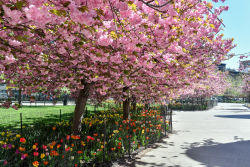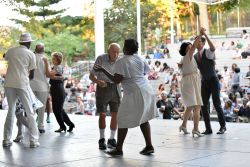Marcus Garvey Park
Marcus Garvey Park
Marcus Garvey Park is named for Marcus Mosiah Garvey (1887-1940), an early advocate of Black Nationalism and economic independence.
Early Dutch settlers referred to this land as “Slangberg,” or Snake Hill, because of its reptile population. Later, the British built fortifications on the site to guard the Harlem River during the Revolutionary War. In 1835, the Common Council, a predecessor to today’s City Council, considered razing the hilly area to accommodate extending Fifth Avenue north of Central Park, but local citizens successfully petitioned to preserve the space as a public park. The land was allotted for public use in 1836 and Mount Morris Park opened to the public in 1840.
A number of architectural elements have been added to the park over time. A fire watchtower, designed by Julius Kroehl, was erected in 1856, a time when fire could have destroyed the mostly wooden city. The tower was restored in 1937-38 using WPA funds to reconstruct the park. The project also added a large surrounding plaza, known as “The Acropolis” at the top of the hill, as well as a community center, and a child health station. The 47-foot cast-iron tower is unique in the United States, and it was designated a New York City landmark in 1967 and listed on the National Register of Historic Places. The tower was stabilized in 1991 and fully restored in 2019.
Mount Morris Park was renamed Marcus Garvey Park in 1977. Garvey, born in St. Ann’s Bay, Jamaica on August 17, 1887, immigrated to Harlem in 1916, where in 1918 he established the headquarters of his Universal Negro Improvement Association (UNIA). At UNIA’s first convention, held at Madison Square Garden in 1920, Garvey declared his plans to build an independent nation in West Africa. The group promoted black economic self-sufficiency, publishing the Negro World newspaper and establishing black-owned businesses, including the Black Star Shipping Line.
Under increasing government scrutiny, Garvey’s plans foundered after his conviction for mail fraud in 1923. After Garvey served two years in prison, President Calvin Coolidge commuted his sentence, and in 1927 he was deported to Jamaica. There he helped establish the first modern political organization, which focused on rights for the poor and working class. Garvey subsequently moved to London, where he died from complications of a stroke in 1940. Though a number of his peers, including W.E.B. Du Bois and the NAACP, were critical of his separatist beliefs, his supporters focus on Garvey’s steadfast pride in African history and culture. Having coined the phrase “black is beautiful,” Garvey’s cultural movement continues to have a lasting impact on today’s society.
Current facilities include the Pelham Fritz Recreation Center (named for a long-serving NYC Parks employee), an amphitheater, and a swimming pool that was built in the early 1970s. In 2011, the amphitheater was reopened after a major restoration. The venue was renamed Richard Rodgers Amphitheater after the famous composer, who grew up across from the park and had also donated funds for the original bandshell in 1970. The historic park setting coupled with the amphitheater’s large stage and upgraded facilities create one of the premier outdoor performance spaces that New York City has to offer.
The park remains a vibrant community resource with the support of the Marcus Garvey Park Alliance, which organizes ongoing arts and cultural programming, in addition to supporting capital projects, park maintenance, and beautification.
Check out your park's Vital Signs
Clean & Safe
Green & Resilient
Empowered & Engaged Users
Share your feedback or learn more about how this park is part of a
Vital Park System










